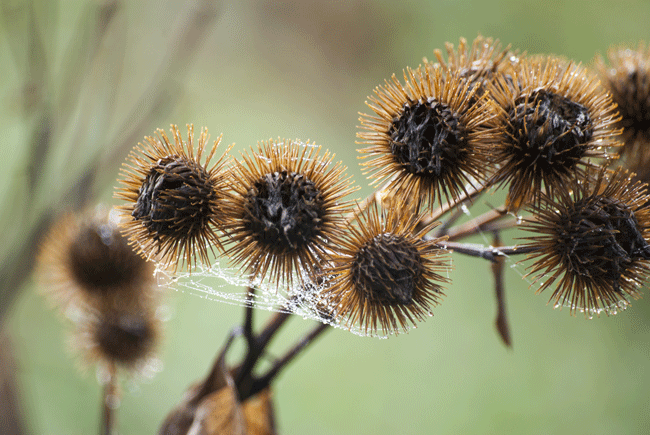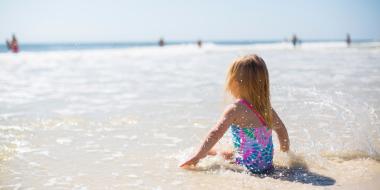Isn’t it curious that even though plants can’t walk, they still manage to show up in the strangest of places? But plants can’t just pick up and move, so how do wild seeds disperse and find their way to new homes?
It turns out that plants have many ingenious ways to disperse their seeds. Read on and try out some fun games and activities too!
Seeds That Fly
Some seeds – like dandelion, milkweed, or goatsbeard – ride the currents of the wind, floating like they have their own parachute! Once done flowering, a dandelion head becomes filled with fluffy, white seeds. If you were to take a magnifying glass and study a plume (or pappus), you’d discover the delicate filaments that form a canopy over the seed hanging beneath it. If you released the plume, it would, quite literally, dance on the wind! The seed is coated in tiny spikes which, like football cleats, help the seed grab the ground when it comes in for a landing.
Activities to try with wind-dancing seeds
- In the late fall, find a milkweed pod just starting to split. Leave in a dry place until the pod has completely opened up. Plan a seed race! Set up a course with start and finish lines about 10 metres apart. Line up at the start and place one milkweed seed in front of each of contestant. See who can blow their milkweed seed past the finish line first.
- Maple keys (the seeds from maple trees) also take advantage of the wind. When they spin, they create a small tornado-like vortex that generates lift – helping each key to sail further away from the tree. Pinecones also have tiny winged seeds that are dropped and drift around when the cone opens!
- Choose a maple key and make sure it is well-winged! The goal of this game is to try and be the last one to touch the ground. Drop your key from a high place (a balcony or even the top of a stairwell would work – just make sure to be careful!) and watch the key slowly swirl its way down, down, down!
Seed bombs

Some seeds literally explode! A great example of this phenomenon is jewelweed. An annual that relies on spreading its seeds for survival, jewelweed seeds are housed in small pods that grow and stretch in the fall, creating pressure until they finally explode, casting seeds up to two metres away. Other plants that pop their seeds are yellow wood sorrel, violets (their seeds are ejected in the same way your fingers can launch a wet watermelon seed by squeezing), and exploding cucumber. All it takes is a gentle touch of your finger or an animal moving among the plants to help spread those seeds far and wide!
Watch jewelweed pop!
In early to mid-September, find a wet area that has plenty of jewelweed growing. Look closely and locate the plump seed pods hanging down. They are quite small, perhaps a ¼ to ½ inch in length. Touch the bottom of the pod, stand back, and watch the seeds cast about in all directions!
Cling-on seeds

Some seeds, such as burdock, have a series of tiny hooks that are made for sticking to things – especially fur. The fur-bearer then carries it away to a new home! In the 1940s, George de Mestral, a Swiss engineer, came up with the idea of Velcro after spending a lot of time removing some very sticky burdock seeds from the coat of his dog! Other examples of sticky seeds include: tick trefoil, bidens, and wild carrot.
Seedy sock walk
Go on a sock walk! Place an old large sock over one shoe and walk through the long grass of a field. Examine your socks: how many hitchhikers stuck on for a ride? Use a magnifying glass to study how the seed was able to stick to the sock.
Poop-planting seeds

Many plants (like blueberries and raspberries) have colourful fruit that is eaten by birds, mammals, and even insects. Their digestive juices are able to break down the tough outer coating of the seed, and what remains is dispersed through, yes, you guessed it, their scat or poop; often far from the parent plant. A nice fertile pile provides the nutrients for seeds to grow and thrive.
A poop-planting seed poem
Here’s a fun poem to help children understand the importance of seed dispersal in scat. To get the rhythm going, alternate between a hand clap and a thigh slap. Say one line of the scat poem and have your kids repeat each line after you, while continuing your clapping and slapping.
Scat Rap
Starts with an “S”, ends with a “T,”
It comes out of you, and it comes out of me,
I know what you’re thinking, but don’t call it that,
Be scientific, and call it SCAT.
If you wanna find out what animals eat,
Take a good look at what they excrete.
Stuck in the scat are all kinds of clues,
Parts of the food that their bodies can’t use.
Down by the creek on a hollow log,
Scat full of berries and bones of frogs.
Fresh last night he was out with the moon,
Hunting crawdads, it was Mr. Raccoon.
You park your car by a wood or field,
Gonna find scat on your window shield.
Full of seeds, purple and white,
You just got bombed by a bird in flight.
If you wanna know what’s in the woods or around,
Take a good long look at the scat on the ground.
It tells us what they eat and tells us who they are,
And that’s what we know about scat so far.






